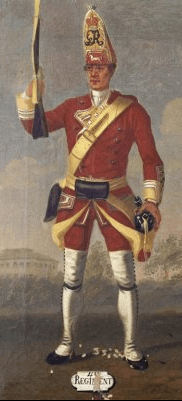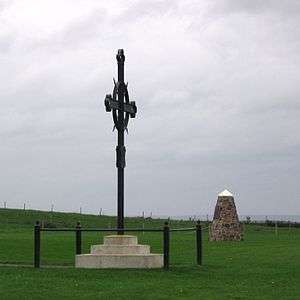Siege of Grand Pré
| ||||||||||||||||||||||||||||||
The Siege of Grand Pré happened during Father Le Loutre’s War and was fought between the British and the Wabanaki Confederacy and Acadian militia. The siege happened at Fort Vieux Logis, Grand Pré (present-day Hortonville, Nova Scotia). The native and Acadia militia laid siege to Fort Vieux Logis for a week in November 1749.[3] One historian states that the intent of the siege was to help facilitate the Acadian Exodus from the region.[4]
Historical context

| Military history of Mi’kmaq people | ||||||||||||||||||||||||||||||||||||||||||||||||||||||||||||||||
|---|---|---|---|---|---|---|---|---|---|---|---|---|---|---|---|---|---|---|---|---|---|---|---|---|---|---|---|---|---|---|---|---|---|---|---|---|---|---|---|---|---|---|---|---|---|---|---|---|---|---|---|---|---|---|---|---|---|---|---|---|---|---|---|---|
 Mi’kmaq Warrior | ||||||||||||||||||||||||||||||||||||||||||||||||||||||||||||||||
| Events | ||||||||||||||||||||||||||||||||||||||||||||||||||||||||||||||||
|
||||||||||||||||||||||||||||||||||||||||||||||||||||||||||||||||
| Other | ||||||||||||||||||||||||||||||||||||||||||||||||||||||||||||||||
|
| ||||||||||||||||||||||||||||||||||||||||||||||||||||||||||||||||
Despite the British Conquest of Acadia in 1710, Nova Scotia remained primarily occupied by Catholic Acadians and Mi'kmaq. By the time Cornwallis had arrived in Halifax, there was a long history of the Wabanaki Confederacy (which included the Mi'kmaq) protecting their land by killing British civilians along the New England/ Acadia border in Maine (See the Northeast Coast Campaigns 1688, 1703, 1723, 1724, 1745, 1746, 1747).[5]
To prevent the establishment of Protestant settlements in the region, Mi'kmaq raided the early British settlements of present-day Shelburne (1715) and Canso (1720). A generation later, Father Le Loutre's War began when Edward Cornwallis arrived to establish Halifax with 13 transports on June 21, 1749.[6] By unilaterally establishing Halifax the British were violating earlier treaties with the Mi'kmaq (1726), which were signed after Father Rale's War.[7]
Within 18 months of establishing Halifax, the British also took firm control of peninsula Nova Scotia by building fortifications in all the major Acadian communities: present-day Windsor (Fort Edward); Grand Pre (Fort Vieux Logis) and Chignecto (Fort Lawrence). (A British fort - Fort Anne - already existed at the other major Acadian centre of Annapolis Royal, Nova Scotia. Cobequid remained without a fort.) There were numerous Mi'kmaq and Acadian raids on these fortifications such as the Siege of Grand Pre.
Just prior to the Siege, on September 30, 1749, about forty Mi'kmaq attacked six men who were cutting trees at a saw mill in Dartmouth, Nova Scotia. Four of them were killed on the spot, one was taken prisoner and one escaped.[8] Two of the men were scalped and the heads of the others were cut off. A detachment of rangers was sent after the raiding party and cut off the heads of two Mi'kmaq and scalped one.[9]
As a result of history of Wabanaki Confederacy raids against British settlers on the New England/ Acadia border and the recent raid in Dartmouth, on October 2, 1749, Cornwallis offered a bounty on the head of every Mi'kmaq. He set the amount at the same rate that the Mi'kmaq received from the French for British scalps. As well, to carry out this task, two companies of rangers were raised, one led by Captain Francis Bartelo and the other by Captain William Clapham. These two companies served alongside that of John Gorham's company. The three companies scoured the land around looking for Mi'kmaq.[10] 'After the destruction of Mirligueche (later known as Lunenburg, Nova Scotia), the Siege of Grand Pre was the first recorded conflict after Cornwallis’ bounty proclamation.
The Siege
On November 27, 1749, 300 Mi'kmaq, Maliseet, Penobscot and a Acadian militia (11 Acadians) attacked Fort Vieux Logis at Grand Pre.[11] The fort was under the command of John Handfield[12] of the 40th Regiment of Foot (Cornwallis' Regiment). The Native and Acadian militia killed the sentrys (guards) who were firing on them.[13] The Natives then captured Lieutenant John Hamilton (Otho Hamilton's son) and eighteen soldiers under his command (including Handfield's son William),[14] while surveying the fort's environs.[15] (They also captured six women and a soldier nearby.)[16] After the capture of the British soldiers, the native and Acadian militias made several attempts over the next week to lay siege to the fort before breaking off the engagement. When Gorham’s Rangers arrived the militia had already departed with the prisoners to Chignecto.[17]
Aftermath
On March 18, 1750, Gorham’s Rangers left Fort Sackville (Nova Scotia), under orders from Governor Cornwallis to march to Piziquid (Windsor). Their mission was to establish a blockhouse at Piziquid (i.e., Fort Edward), and to seize the property of Acadians who had participated in the Siege of Grand Pre.[18] (En route, Gorham engaged the Mi’kmaq in the Battle at St. Croix).
Cornwallis later arrested the Acadians and Father Girrard who were involved in the Siege.[19]
The Mi’kmaq and Acadians continued raids on the Protestant settlements, such as the Raid on Dartmouth (1751) and the Raid on Lunenburg, Nova Scotia (1756). For the Maliseet, it was their first breech of the Peace Treaty that had made with Cornwallis months earlier.[20]
The prisoners spent two years in captivity before being ransomed. In August 1751, Lt. John Hamilton (whose father Otho was formerly on the Nova Scotia Council) and his father-in-law from his first marriage William Shirriff (also a member of the Nova Scotia Council) negotiated the release for Hamilton and the other 60 Englishmen who had been imprisoned over the two years.[21][22] (They were traded for daughter of native chief Captain Sam (Jerome Atecouando[23] - a former soldier of Gorham's. She was taken prisoner at St. John River in 1748 by Gorham's Rangers and kept with Gorham's wife in Boston.[24][25][26][23][27][28]) The Governor and Council paid Le Loutre's ransom of £882 to release sixty prisoners of officers, soldiers and settlers, including Hamilton.[29] As late as June 1754, Captain Hamilton wrote Governor Lawrence a letter of support for Abbe Le Loutre.[30][31][32][26][33]
References
- ↑ "Documentary history of the state of Maine ..". Internet Archive. Retrieved 22 April 2016.
- ↑ Canadian Biography
- ↑ the names of the Acadians as published in the "Selection from the Public Documents of the Province of Nova Scotia" by Thomas Akins, p. 177
- ↑ "Acadia : missing links of a lost chapter in American history". Internet Archive. Retrieved 22 April 2016.
- ↑ John Reid.“Amerindian Power in the Early Modern Northeast: A Reappraisal.” in Essays on Northeastern North America: Seventeenth and Eighteenth Centuries (Toronto: University of Toronto Press, 2008) ; Grenier, John. The Far Reaches of Empire. War in Nova Scotia, 1710-1760. University of Oklahoma Press, Norman, 2008.
- ↑ Grenier, John. The Far Reaches of Empire. War in Nova Scotia, 1710-1760. Norman: U of Oklahoma P, 2008; Thomas Beamish Akins. History of Halifax, Brookhouse Press. 1895. (2002 edition). p 7
- ↑ Wicken, p. 181; Griffith, p. 390
- ↑ Harry Chapman. In the Wake of the Alderney: Dartmouth, Nova Scotia, 1750-2000. Dartmouth Historical Association. 2000. p. 23.
- ↑ Thomas Beamish Akins. History of Halifax, Brookhouse Press. 1895. (2002 edition). p 18.
- ↑ Thomas Beamish Akins. History of Halifax, Brookhouse Press. 1895. (2002 edition). p 19.
- ↑ Beamish Murdoch. History of Nova Scotia vol. 2. p. 172
- ↑ Canadian Biography
- ↑ Brebner, New England's Outpost.p 174
- ↑ list of officers, p.63
- ↑ The son of Captain Otho Hamilton and daughter of Captain Handfield were married in 1752.
- ↑ "Archived copy". Archived from the original on October 20, 2007. Retrieved January 12, 2014.
- ↑ See Faragher 262; Griffith 392; Murdoch, 166-167; Grenier, p. 153; John Salusbury's Diary, Dec. 10, 1749
- ↑ Grenier, p. 153
- ↑ "Selections from the public documents of the province of Nova Scotia". Internet Archive. Retrieved 22 April 2016.
- ↑ "Documentary history of the state of Maine ..". Internet Archive. Retrieved 22 April 2016.
- ↑ Beamish Murdoch. History of Nova Scotia. Vol. 2. p. 204
- ↑ When John Hamilton returned to Port Royal, he married John Hatfield's daughter Elizabeth.
- 1 2 "Biography – ATECOUANDO (fl. 1749-57) – Volume III (1741-1770) – Dictionary of Canadian Biography". www.biographi.ca. Retrieved 22 April 2016.
- ↑ RICHARDS MINOT, GEORGE (1798). CONTINUATION OF THE HISTORY OF THE PROVINCE OF MASSACHUSETTS BAY. New York Public Library. p. 119.
- ↑ "Documentary history of the state of Maine ..". Internet Archive. Retrieved 22 April 2016.
- 1 2 "Documentary history of the state of Maine ..". Internet Archive. Retrieved 22 April 2016.
- ↑ "Documentary history of the state of Maine ..". Internet Archive. Retrieved 22 April 2016.
- ↑ p. 272
- ↑ (Thomas Akins, History of Halifax City, Chapter 2).
- ↑ "Selections from the public documents of the province of Nova Scotia". Internet Archive. Retrieved 22 April 2016.
- ↑ Le Loutre's letter about Hamilton, p. 15
- ↑ In 1899, Rev. Arthur Wentworth Hamilton Eaton of Halifax, Nova Scotia owned a portrait of John Hamilton and another of his wife Katherine Arbuckley.
- ↑ "Collection de documents inédits sur le Canada et l'Amérique [microforme]". Internet Archive. Retrieved 22 April 2016.
Literature cited
- Faragher, John. Great and Noble Scheme. New York: Norton, 2005.
- Grenier, John. The Far Reaches of Empire. War in Nova Scotia, 1710-1760. Norman: U of Oklahoma P, 2008. pp. 154–155.
- Griffiths, Naomi Elizabeth Saundaus. From Migrant to Acadian: A North American border people, 1604-1755. Montreal, Kingston: McGill-Queen's UP, 2005.
- Landry, Peter. The Lion & The Lily. Vol. 1. Victoria: Trafford, 2007.
- Murdoch, Beamish. A History of Nova Scotia, Or Acadia. Vol 2. LaVergne: BiblioBazaar, 2009. pp. 166–167.
- Rompkey, Ronald, ed. Expeditions of Honour: The Journal of John Salusbury in Halifax, Nova Scotia, 1749-53. Newark: U of Delaware P, Newark, 1982.
